 The rate of growth in India has fallen to its lowest level since the first three months of 2009 – the period when many countries were plunging into recession. Although the annual rate was still 4.4% in Q2 2013 (a rate most Western governments would love to achieve!), it had averaged 8.2% from 2003 to 2007 and 9.5% from 2010 to 2011 (see).
The rate of growth in India has fallen to its lowest level since the first three months of 2009 – the period when many countries were plunging into recession. Although the annual rate was still 4.4% in Q2 2013 (a rate most Western governments would love to achieve!), it had averaged 8.2% from 2003 to 2007 and 9.5% from 2010 to 2011 (see).
And the rupee has been falling in value (see chart below). The exchange rate of the rupee to the dollar has depreciated by 21% since the start of the year and by 14% since the beginning of August (click here for a PowerPoint of the chart). This has pushed up the price of imports and raised fears that inflation, already approaching 10%, will rise.
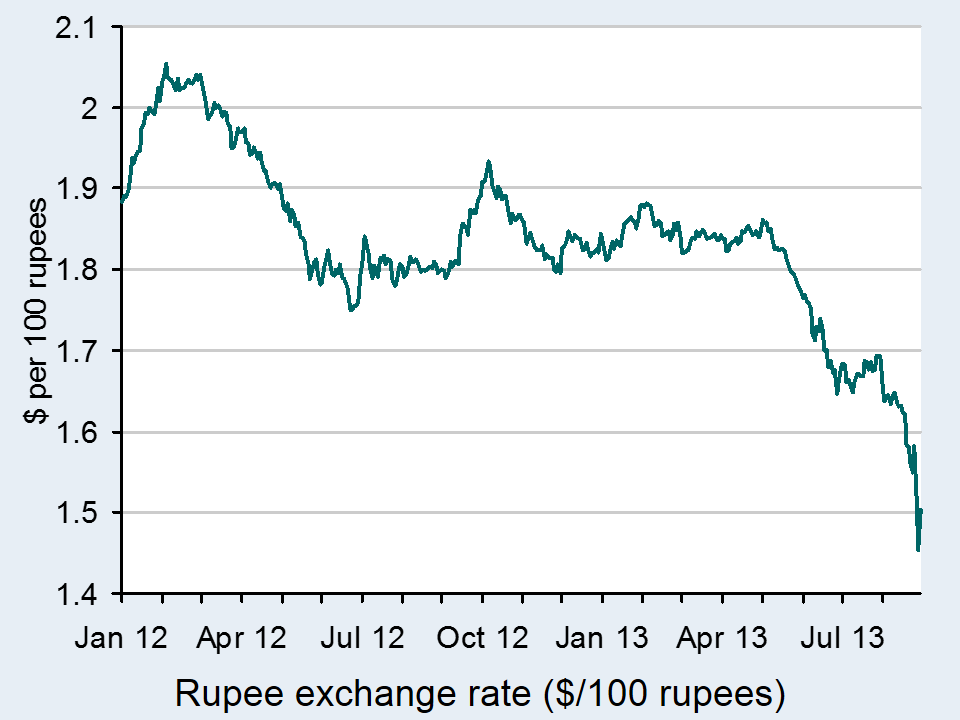 There have also been concerns about the health of India’s banking sector, with worries over the possible rise in bad loans.
There have also been concerns about the health of India’s banking sector, with worries over the possible rise in bad loans.
One result of all these factors is that the confidence of investors has been shaken. Bond prices have fallen and so too have share prices. The Mumbai Sensex index fell by 11.5% from 22 July to 27 August. Worried about possible capital flight, the Indian government imposed capital controls on Indian residents on 14 August. It has, however, since ruled out limiting the outflow of funds by foreign investors.
The following articles and videos look at the causes of the current economic problems and what can be done about them.
Webcasts
 India’s sliding economy Aljazeera (24/8/13)
India’s sliding economy Aljazeera (24/8/13)
 Economic woes grow for Indians as rupee continues to slide BBC News, Sanjoy Majumder (30/8/13)
Economic woes grow for Indians as rupee continues to slide BBC News, Sanjoy Majumder (30/8/13)
 What is behind the Indian economy’s fall from grace? BBC News, Yogita Limaye (30/8/13)
What is behind the Indian economy’s fall from grace? BBC News, Yogita Limaye (30/8/13)
 Indian rupee: How onions reflect health of economy BBC News, Nitin Srivastava (30/8/13)
Indian rupee: How onions reflect health of economy BBC News, Nitin Srivastava (30/8/13)
 The rise and fall of India’s economy NDTV (20/8/13)
The rise and fall of India’s economy NDTV (20/8/13)
 Is the Indian economy heading for a doom? NDTV, Dr Arvind Virmani, Adi Godrej, P N Vijay, Sanjay Nirupam and Prakash Javadekar (20/7/13)
Is the Indian economy heading for a doom? NDTV, Dr Arvind Virmani, Adi Godrej, P N Vijay, Sanjay Nirupam and Prakash Javadekar (20/7/13)
 Can Rajan stabilise India’s economy? FT Video, Stuart Kirk and Julia Grindell (7/8/13)
Can Rajan stabilise India’s economy? FT Video, Stuart Kirk and Julia Grindell (7/8/13)
Articles
India in trouble: The reckoning The Economist (24/8/13)
PM warns of short term shocks, attacks BJP for stalling Parliament The Economic Times of India (31/8/13)
External global factors led to rupee slide: Manmohan in Lok Sabha Hindustan Times (30/8/13)
India seeks allies to defend rupee as growth skids to four-year low Reuters, Manoj Kumar and Frank Jack Daniel (30/8/13)
Rupee charts in uncharted territory Reuters, Saikat Chatterjee and Subhadip Sircar (30/8/13)
Indian Prime Minister Says Rupee Crisis Will Only Make Country Stronger Time World, ilanjana Bhowmick (30/8/13)
Is India in danger of another crisis? BBC News, Linda Yueh (8/8/13)
India’s GDP shows continuing slowdown BBC News (30/8/13)
Slowest India Growth Since 2009 Pressures Singh to Support Rupee Bloomberg, Unni Krishnan (30/8/13)
Questions
- Why has the rupee fallen in value so dramatically? Is there likely to have been overshooting?
- What are the economic consequences of this large-scale depreciation? Who gain and who lose?
- What factors are likely to affect the rate of growth in India over the coming months?
- Why is the Indian economy more vulnerable than many other Asian economies?
- What economic policies are being pursued by the Indian government? How successful are they likely to be?
 In our blog How sustainable is UK consumer spending? we considered concerns of some commentators that consumer spending was growing unduly quickly given the absence of any sustained growth in disposable income. The Second Estimate of GDP, Q2 2013 reports that the economy grew by 0.7 per cent in the second quarter of the year, with household expenditure growing by 0.4 per cent.
In our blog How sustainable is UK consumer spending? we considered concerns of some commentators that consumer spending was growing unduly quickly given the absence of any sustained growth in disposable income. The Second Estimate of GDP, Q2 2013 reports that the economy grew by 0.7 per cent in the second quarter of the year, with household expenditure growing by 0.4 per cent.
Because household spending makes up about two-thirds of aggregate demand in the UK it is important to keep an eye on it. The latest figures show that the real value of consumer spending by British households has risen in each quarter since 2011 Q4. In other words, the volume of household purchases has risen for seven consecutive quarters. Over the period, the growth in real consumer spending has averaged 0.4 per cent per quarter.
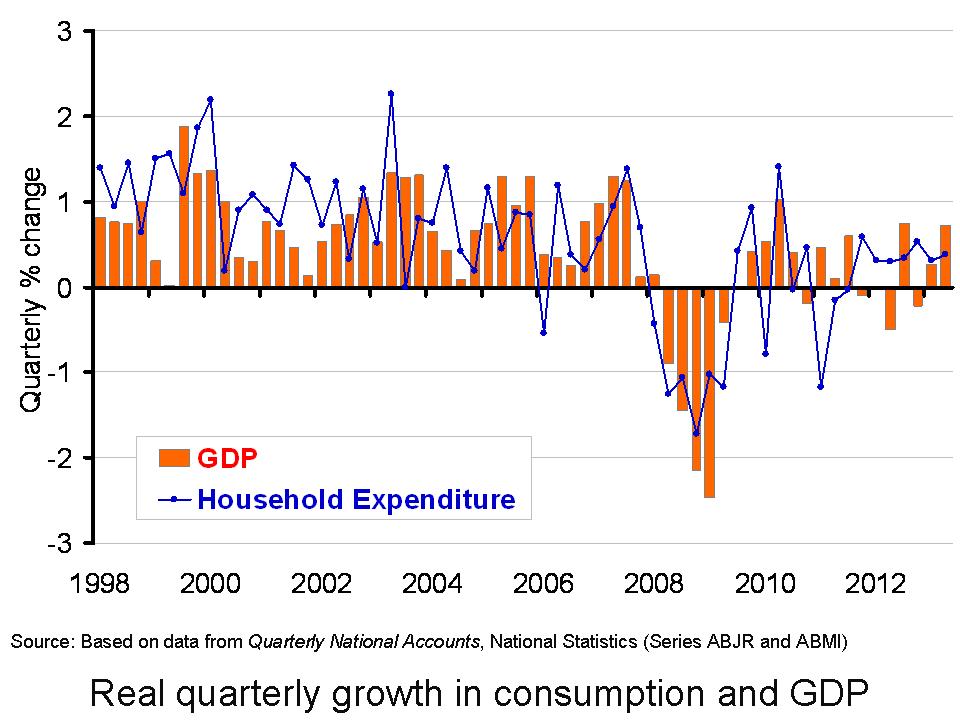 The chart helps to demonstrate the stark turnaround in the growth in consumer spending. Over the period from 2008 Q1 to 2011 Q3, real consumer spending typically fell by 0.4 per cent each quarter. As we noted in our previous blog, this was a period when the global financial system was in distress, with the availability of credit severely dampened, but also a period when households were concerned about their own financial balances and the future prospects for growth. Over the same period, real GDP typically fell by a little under 0.3 per cent each quarter. (Click here to download a PowerPoint of the chart.)
The chart helps to demonstrate the stark turnaround in the growth in consumer spending. Over the period from 2008 Q1 to 2011 Q3, real consumer spending typically fell by 0.4 per cent each quarter. As we noted in our previous blog, this was a period when the global financial system was in distress, with the availability of credit severely dampened, but also a period when households were concerned about their own financial balances and the future prospects for growth. Over the same period, real GDP typically fell by a little under 0.3 per cent each quarter. (Click here to download a PowerPoint of the chart.)
The real value of consumer spending has yet to return to its 2007 Q4 peak (£242 billion at 2010 prices). In 2013 Q2 the real value of consumer spending is estimated still to be 3 per cent below this level (£235 billion at 2010 prices). These figures are mirrored by the economy at large. Real GDP peaked in 2008 Q1 (£393 billion at 2010 prices). Despite the back-to-back quarterly increases in real GDP of 0.3 per cent in Q1 and 0.7 per cent in Q2, output in 2013 Q2 (£380 billion at 2010 prices) remains 3.2 per cent below the 2008 Q1 peak.
While real consumption values are below their 2007 Q4 peak, the concern is whether current rates of growth in consumer spending are sustainable. In particular, should this growth cause the household sector financial distress there would be real pain for the economy further down the line. Some commentators argue that the latest GDP figures are consistent with a more balanced recovery. In Q2 economic growth was supported too by other parts of the economy. For instance, we saw a 3.6 per cent rise in export volumes and a 1.7 per cent rise in gross fixed capital formation (i.e. investment expenditure).
Nonetheless, it is the protracted period over which consumer spending has been growing robustly that concerns some economists. Hence, we will need to continue to monitor the growth in all components of aggregate demand and, in particular, changes in household consumption, income, saving and borrowing.
Data
Second Estimate of GDP, Q2 2013 Dataset Office for National Statistics
Articles
New articles
UK economic growth revised up to 0.7% BBC News, (23/8/13)
UK GDP revised up to 0.7pc in second quarter: reaction Telegraph, (23/8/13)
UK rallying faster than thought as exports leap boosts GDP Independent, Russell Lynch and Ben Chu (24/8/13)
UK economy expanding faster than first thought, GDP revision shows Guardian, Heather Stewart (23/8/13)
Growth upgrade points to ‘sustainable’ recovery Telegraph, Philip Aldrick (23/8/13)
Previous articles
UK wages decline among worst in Europe BBC News, (11/8/13)
Squeezing the hourglass The Economist, (10/8/13)
UK first-quarter growth unchanged BBC News, (28/5/13)
Summer heatwave triggers shopping spree in ‘Wongaland’ economy Telegraph, Steve Hawkes and Steven Swinford (15/8/13)
Retail sales data better than expected as UK economy enjoys summer bounce Guardian, Heather Stewart (15/8/13)
Mark Carney is banking on you to keep spending Telegraph, Philip Aldrick (10/8/13)
NIESR upgrades UK economy but warns on consumer spending Telegraph, Philip Aldrick (2/8/13)
Consumers ‘expect better economy’ Belfast Telegraph, (4/8/13)
Questions
- Explain what you understand by a ‘sustainable’ economic recovery.
- What are the expenditure components that make up Aggregate Demand?
- Explain what you understand by consumption smoothing.
- Why would we would typically expect consumption growth to be less variable than that in disposable income?
- Would we expect consumption growth to always be less variable than that in disposable income? Explain your answer.
- What impact do you think the financial crisis has had on consumer behaviour?
- To what extent do you think the current growth in consumer spending is sustainable?
- How important are expectations in determining consumer behaviour?
 Household spending makes up about two-thirds of aggregate demand in the UK. Understanding its determinants is therefore important to understanding short-term economic growth. The real value of consumer spending by British households has risen in each quarter since 2011 Q4. Over the same period real disposable income has flat-lined. This suggests that the British household sector has stepped up attempts to smooth their longer-term spending profile despite the current absence of growth in their real incomes.
Household spending makes up about two-thirds of aggregate demand in the UK. Understanding its determinants is therefore important to understanding short-term economic growth. The real value of consumer spending by British households has risen in each quarter since 2011 Q4. Over the same period real disposable income has flat-lined. This suggests that the British household sector has stepped up attempts to smooth their longer-term spending profile despite the current absence of growth in their real incomes.
When viewed over many years, disposable income and consumer spending grow at very similar rates. After stripping out inflation we find that over the past 50 years both have grown at about 2½ per cent per annum. However, if we measure growth from one quarter of the year to the next we tend to find that consumption growth is less variable than disposable income. This is known as consumption smoothing.
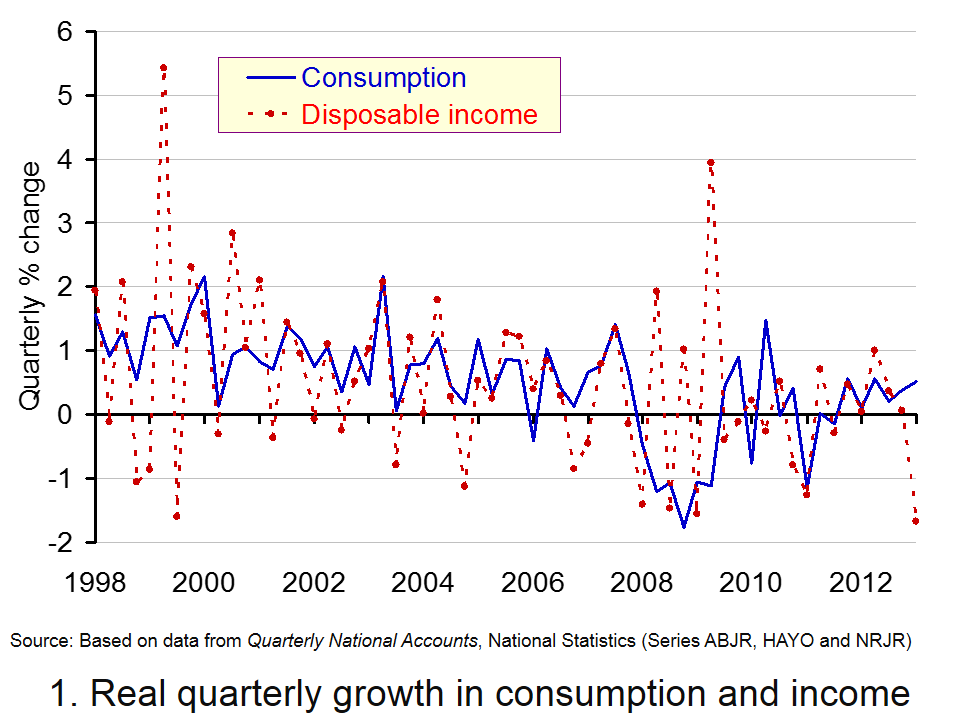 Chart 1 shows the quarterly percentage change in consumption and disposable income since 1998. (Click here to download a PowerPoint of the chart).The variability in the disposable income series is generally greater than that in consumption so helping to illustrate consumption smoothing.
Chart 1 shows the quarterly percentage change in consumption and disposable income since 1998. (Click here to download a PowerPoint of the chart).The variability in the disposable income series is generally greater than that in consumption so helping to illustrate consumption smoothing.
Consumption smoothing is facilitated by the financial system enabling us to either borrow to supplement our spending or to save to enjoy more spending in the future. The financial system can help households to avoid large variations in their spending over short periods.
Consumption smoothing does not prohibit falls in consumption nor periods when it is more variable than income. Over the period from 2008 Q1 to 2011 Q3, real consumption typically fell by 0.4 per cent each quarter while disposable income was flat. This was a period when the global financial system was in distress. Sharp contractions in credit meant that the financial system was no longer able to support economic activity as it had previously. Furthermore, households too looked to repair their balance sheets with economic uncertainty acting as an incentive to do so.
What is interesting is the extent to which British households are spending again. Since 2011 Q4 the real value of spending has typically expanded by 0.4 per cent each quarter while income growth remains largely absent. One might argue that this just demonstrates a willingness for households to engage in consumption smoothing. With credit conditions still tight, the growth in spending has been aided by a decline in the saving ratio. 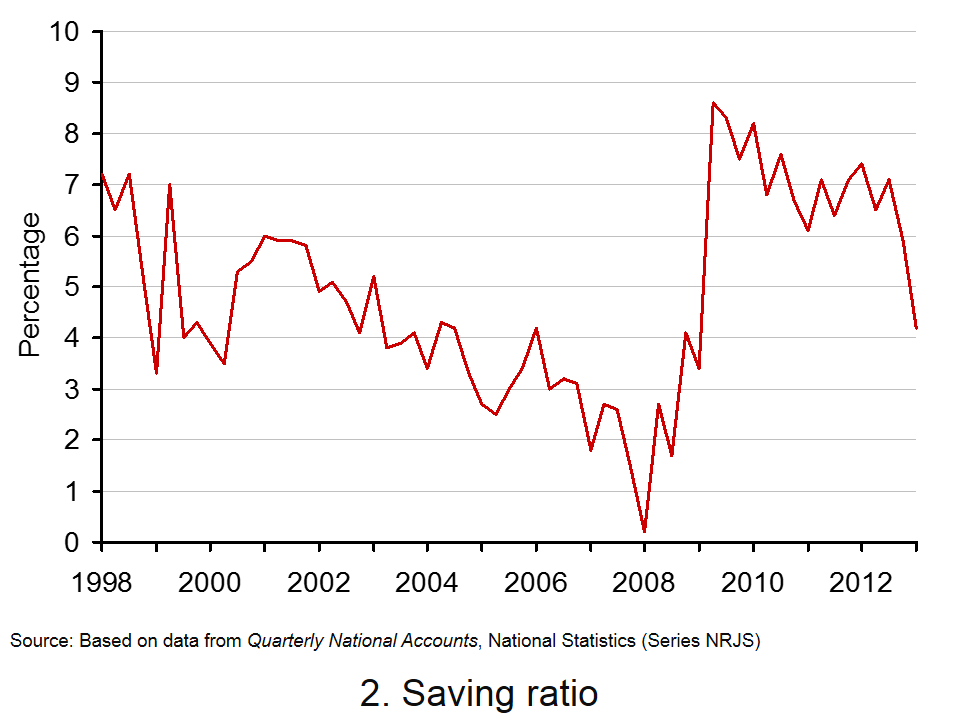 This can be seen from Chart 2.
This can be seen from Chart 2.
In 2009 Q2 the proportion of income saved hit 8.6 per cent having been as low as 0.2 per cent in 2008 Q1. In 2013 Q1 the saving ratio had fallen back to 4.2 per cent. (Click here to download a PowerPoint of the chart.)
It is of course all too easy to over-interpret data. Nonetheless, there be will concern if households look to maintain consumption growth at rates substantially greater than those in disposable income for too long a period of time. Consumption smoothing could become a real problem for future economic activity if it was to result in a financially distressed household sector. Hence, an important question is the extent to which current rates of consumption growth are sustainable. Future consumption and income trends will therefore be analysed with enormous interest.
Data
Quarterly National Accounts, Q1 2013 Dataset Office for National Statistics
Articles
UK wages decline among worst in Europe BBC News, (11/8/13)
Squeezing the hourglass The Economist, (10/8/13)
UK first-quarter growth unchanged BBC News, (28/5/13)
Summer heatwave triggers shopping spree in ‘Wongaland’ economy Telegraph, Steve Hawkes and Steven Swinford (15/8/13)
Retail sales data better than expected as UK economy enjoys summer bounce Guardian, Heather Stewart (15/8/13)
Mark Carney is banking on you to keep spending Telegraph, Philip Aldrick (10/8/13)
NIESR upgrades UK economy but warns on consumer spending Telegraph, Philip Aldrick (2/8/13)
Consumers ‘expect better economy’ Belfast Telegraph, (4/8/13)
Questions
- Explain what you understand by consumption smoothing.
- Why would we would typically expect consumption growth to be less variable than that in disposable income?
- Would we expect consumption growth to always be less variable than that in disposable income? Explain your answer.
- What impact do you think the financial crisis has had on consumer behaviour?
- To what extent do you think the current growth in consumer spending is sustainable?
- How important are expectations in determining consumer behaviour?
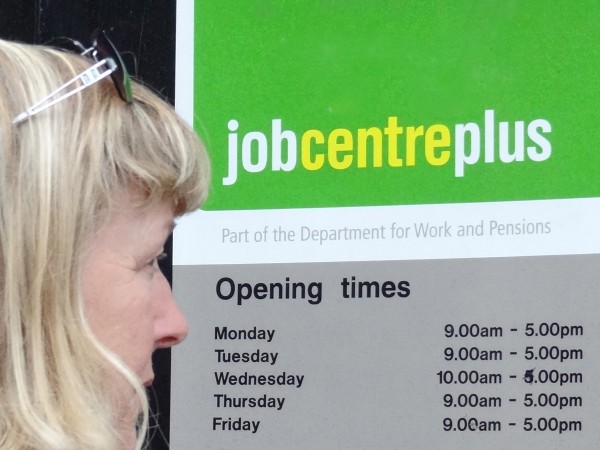 UK unemployment fell by 4000 to 2.51 million in second quarter of this year. But this was too small to have any significant effect on the unemployment rate, which remained at 7.8%.
UK unemployment fell by 4000 to 2.51 million in second quarter of this year. But this was too small to have any significant effect on the unemployment rate, which remained at 7.8%.
According to the forward guidance issued by the Bank of England, Bank Rate will stay at 0.5%, barring serious unforeseen circumstances, until unemployment reaches 7%. So will this be soon?
There are good reasons to suggest that the answer is no. Reasons include the following:
(a) Many firms may choose to employ their part-time workers for more hours, rather than taking on extra staff, if the economy picks up.
 (b) The recovery is being fuelled by a rise in consumption, which, in turn, is being financed by people drawing on savings or borrowing more. The household saving ratio fell from 7.4% in 2012 Q1 to 4.2% in 2013 Q1. This trend will be unsustainable over the long run, especially as the Bank of England may see a rapid rise in borrowing/decline in saving as serious enough to raise interest rates before the unemployment rate has fallen to 7%.
(b) The recovery is being fuelled by a rise in consumption, which, in turn, is being financed by people drawing on savings or borrowing more. The household saving ratio fell from 7.4% in 2012 Q1 to 4.2% in 2013 Q1. This trend will be unsustainable over the long run, especially as the Bank of England may see a rapid rise in borrowing/decline in saving as serious enough to raise interest rates before the unemployment rate has fallen to 7%.
(c) Despite the modest recovery, people’s average real incomes are well below the levels prior to the deep recession of 2008/9.
The articles consider the outlook for the economy and unemployment
Articles
UK unemployment holds steady at 7.8pc The Telegraph, Rebecca Clancy (14/8/13)
Unemployment rate is unlikely to fall sharply The Guardian, Larry Elliott (14/8/13)
UK unemployment falls by 4,000 to 2.51 million BBC News (14/8/13)
UK wages decline among worst in Europe BBC News (11/8/13)
Squeezing the hourglass The Economist (10/8/13)
 More people in work than ever before as unemployment falls Channel 4 News, Faisal Islam (14/8/13)
More people in work than ever before as unemployment falls Channel 4 News, Faisal Islam (14/8/13)
Data
Labour Market Statistics, August 2013 ONS
United Kingdom National Accounts, The Blue Book, 2013: Chapter 06: Households and Non-profit Institutions Serving Households (NPISH) ONS
Questions
- What factors determine the rate of unemployment?
- With reference to the ONS data in Labour Market Statistics, August 2013 above, what has happened to (a) the long-term unemployment rate; (b) the unemployment rate for 18–24 year olds?
- How would you define ‘living standards’?
- How is labour productivity relevant to the question of whether unemployment is likely to fall?
- How much have living standards fallen since 2008?
- Under what circumstances might the Bank of England raise interest rates before the rate of unemployment has fallen to 7%?
- Property prices are beginning to rise. Consider the effects of this and whether, on balance, a rise in property prices is beneficial.
 Despite the prolonged stagnation in the UK, unemployment has not soared. In fact, over the past two years the ILO unemployment rate (see here for a definition) has fallen slightly – from 8.6% in October 2011 to around 8.0% today. What is more, the claimant count rate is considerably lower than the ILO rate – at around 4.4%.
Despite the prolonged stagnation in the UK, unemployment has not soared. In fact, over the past two years the ILO unemployment rate (see here for a definition) has fallen slightly – from 8.6% in October 2011 to around 8.0% today. What is more, the claimant count rate is considerably lower than the ILO rate – at around 4.4%.
Part of the reason for the relatively good unemployment figures is the rise in ‘zero-hours contracts’. These allow employers to cut the hours that people work without laying them off. The Office for National Statistics estimates that last year (2012) 250,000 people, or 0.84% of the workforce, were on such contracts.
But just what is meant by ‘zero-hours contracts’? According to the ONS:
People on zero-hours contracts are classified as being in employment regardless of the number of hours they actually worked during the survey reference week. This includes anyone who was not required to work any hours during the reference week whilst remaining on their current contract of employment. The continued existence of the contract of employment is the key determinant of their employment status in these situations.
If people are working less than they would like to, this is classified as underemployment, but such people do not appear in the unemployment statistics. Such contracts thus mask the true extent of surplus labour in the economy.
The Chartered Institute of Personnel and Development (CIPD) puts the figure much higher than the ONS. In the Summer 2013 issue of its Labour Market Outlook, it estimates that one million workers are on zero-hours contracts.
 Many employers use such contracts, including many voluntary-sector and public-sector organisations, including the NHS, local councils and Buckingham Palace. They are also used by many small and medium-sized enterprises and many well-known large companies, such as Sports Direct, Amazon, JD Wetherspoon and Cineworld. It gives them the flexibility to adjust the hours they employ people. It allows them to keep people in employment when demand is low. It also makes them more willing to take on staff when demand rises, as it removes the fear of being over-staffed if demand then falls back.
Many employers use such contracts, including many voluntary-sector and public-sector organisations, including the NHS, local councils and Buckingham Palace. They are also used by many small and medium-sized enterprises and many well-known large companies, such as Sports Direct, Amazon, JD Wetherspoon and Cineworld. It gives them the flexibility to adjust the hours they employ people. It allows them to keep people in employment when demand is low. It also makes them more willing to take on staff when demand rises, as it removes the fear of being over-staffed if demand then falls back.
But many workers dislike such contracts, which give them fewer employment rights and fewer hours than they would like to work. It also makes it difficult to budget when future income is uncertain. It also make credit and mortgages harder to obtain, as people have no guaranteed income. Another complaint is that companies may use the threat of lower hours as a tool to bully staff and get away with poorer working conditions.
In May of this year, the Business Secretary, Vince Cable, announced that he was setting up a review of zero hours contracts.
 Note that zero hours are not the only form of flexible working. Other examples include: ‘self-employed’ workers, contracted separately for each job they do for a company; people paid largely or wholly on commission; on-call working; part-time working, where the hours are specified in advance, but where these are periodically re-negotiated; overtime; people producing a product or service for a company (perhaps at home), where the company varies the amount paid per unit according to market conditions.
Note that zero hours are not the only form of flexible working. Other examples include: ‘self-employed’ workers, contracted separately for each job they do for a company; people paid largely or wholly on commission; on-call working; part-time working, where the hours are specified in advance, but where these are periodically re-negotiated; overtime; people producing a product or service for a company (perhaps at home), where the company varies the amount paid per unit according to market conditions.
The following videos and articles look at the issue in some detail: at the extent of the practice and at its benefits to employers and its costs (and some benefits) to workers. Both The Guardian and the BBC have an extensive range of articles on the topic.
Webcasts
 Do zero hours contracts create real jobs? BBC Newsnight, Allegra Stratton (14/8/12)
Do zero hours contracts create real jobs? BBC Newsnight, Allegra Stratton (14/8/12)
 Record number of ‘Zero Hours Contracts’ ITV News on YouTube, Laura Kuenssberg (2/5/13)
Record number of ‘Zero Hours Contracts’ ITV News on YouTube, Laura Kuenssberg (2/5/13)
 Britons rally against ‘Zero Hour’ contracts Al Jazeera on YouTube (4/8/13)
Britons rally against ‘Zero Hour’ contracts Al Jazeera on YouTube (4/8/13)
 Anger at Amazon working conditions Channel 4 News (1/8/13)
Anger at Amazon working conditions Channel 4 News (1/8/13)
 Government to include Amazon in its zero hours probe Channel 4 News (2/8/13)
Government to include Amazon in its zero hours probe Channel 4 News (2/8/13)
 Councils using zero hours contracts BBC London, Warren Nettleford (31/7/13)
Councils using zero hours contracts BBC London, Warren Nettleford (31/7/13)
Podcasts
 The real economy: Labour market BBC Today Programme, Evan Davis (24/8/11)
The real economy: Labour market BBC Today Programme, Evan Davis (24/8/11)
 Zero hour contracts ‘just the norm’ BBC Today Programme, Rochelle Monte and Peter Cheese (5/8/13)
Zero hour contracts ‘just the norm’ BBC Today Programme, Rochelle Monte and Peter Cheese (5/8/13)
Articles
Zero-hours contracts: One million British workers could be affected Independent, Nigel Morris (5/8/13)
Zero hours contracts “spreading like wildfire”, official stats show Union News, Pete Murray (1/8/13)
Zero-hours contracts: what are they? The Guardian, Phillip Inman (30/7/13)
Buckingham Palace uses zero-hours contracts for summer staff The Guardian, Simon Neville, Matthew Taylor and Phillip Inman (30/7/13)
Nick Clegg: business department will investigate zero-hours contracts The Guardian,
Patrick Wintour, Simon Neville, Matthew Taylor and Phillip Inman (31/7/13)
Zero-hours contracts are not unavoidable The Guardian, Phillip Inman (1/8/13)
ONS admits it underestimated number of zero-hours contracts The Guardian, Simon Neville (1/8/13)
Zero-hours contract workers – the new reserve army of labour? The Guardian, Philip Inman (4/8/13)
Zero-hours contracts cover more than 1m UK workers The Guardian, Simon Goodley and Phillip Inman (5/8/13)
Zero-hours contracts use by councils needs to be moderated The Guardian, Vidhya Alakeson (5/8/13)
If zero-hours contracts are driving this ‘recovery’, it’s a lousy kind of recover The Guardian, Deborah Orr (9/8/13)
ONS increases its estimate of workers on zero hours contracts Financial Times, John Aglionby (1/8/13)
Zero Hours Herald Scotland, Ian Bell and Scott Dickson (4/8/13)
Sports Direct protests planned over zero hours contracts Channel 4 News (3/8/13)
Cable warns of exploitation of zero-hours contracts BBC News (5/8/13)
Q&A: What are zero-hours contracts? BBC News (5/8/13)
Record number of 16-24s on zero hours contracts at work BBC Newsbeat, Jim Reed (15/5/13)
Figures show 18-24s most likely on zero-hours contract BBC Newsbeat, Jim Reed and Amelia Butterly (5/8/13)
Andy Burnham calls for ban on zero hours contracts BBC News (28/4/13)
Zero-hours contracts: What is it like living on one? BBC News, Sean Clare (5/8/13)
Small Talk: Zero-hours contracts? Key for growth Independent, David Prosser (5/8/13)
Zero Hour Contracts Manchester based law firm, Emma Cross (30/7/13)
Data
People and proportion in employment on a zero-hour contract ONS (31/7/13)
Estimating Zero-Hour Contracts from the Labour Force Survey ONS (26/7/13)
One million workers on zero hours contracts, finds CIPD study CIPD, Michelle Stevens (5/8/13)
Labour Market Outlook CIPD
Questions
- Distinguish between open unemployment, disguised unemployment and underemployment?
- Distinguish between functional, numerical and financial flexibility? Which type or types of flexibility do zero-hours contracts give the firm?
- Identify the various benefits to employers of zero-hours contracts?
- What are the costs and benefits to workers of such contracts?
- Identify what forms of flexible contracts are used for staff in your university or educational establishment. Do they benefit (a) staff; (b) students?
- Are zero-hours contracts fair?
- In what ways do zero-hours contracts transfer risks from employers to employees?
- If a company introduces a system of zero-hours contracts, is this in accordance with the marginal productivity theory of profit maximisation from employment?
- From the perspective of the employer, how do the benefits of zero-hours contracts compare with other forms of flexible working?
- Consider the arguments for and against (a) banning and (b) regulating zero-hours contracts.
 The rate of growth in India has fallen to its lowest level since the first three months of 2009 – the period when many countries were plunging into recession. Although the annual rate was still 4.4% in Q2 2013 (a rate most Western governments would love to achieve!), it had averaged 8.2% from 2003 to 2007 and 9.5% from 2010 to 2011 (see).
The rate of growth in India has fallen to its lowest level since the first three months of 2009 – the period when many countries were plunging into recession. Although the annual rate was still 4.4% in Q2 2013 (a rate most Western governments would love to achieve!), it had averaged 8.2% from 2003 to 2007 and 9.5% from 2010 to 2011 (see). There have also been concerns about the health of India’s banking sector, with worries over the possible rise in bad loans.
There have also been concerns about the health of India’s banking sector, with worries over the possible rise in bad loans. India’s sliding economy Aljazeera (24/8/13)
India’s sliding economy Aljazeera (24/8/13) Economic woes grow for Indians as rupee continues to slide BBC News, Sanjoy Majumder (30/8/13)
Economic woes grow for Indians as rupee continues to slide BBC News, Sanjoy Majumder (30/8/13) What is behind the Indian economy’s fall from grace? BBC News, Yogita Limaye (30/8/13)
What is behind the Indian economy’s fall from grace? BBC News, Yogita Limaye (30/8/13) Indian rupee: How onions reflect health of economy BBC News, Nitin Srivastava (30/8/13)
Indian rupee: How onions reflect health of economy BBC News, Nitin Srivastava (30/8/13) The rise and fall of India’s economy NDTV (20/8/13)
The rise and fall of India’s economy NDTV (20/8/13) Is the Indian economy heading for a doom? NDTV, Dr Arvind Virmani, Adi Godrej, P N Vijay, Sanjay Nirupam and Prakash Javadekar (20/7/13)
Is the Indian economy heading for a doom? NDTV, Dr Arvind Virmani, Adi Godrej, P N Vijay, Sanjay Nirupam and Prakash Javadekar (20/7/13) Can Rajan stabilise India’s economy? FT Video, Stuart Kirk and Julia Grindell (7/8/13)
Can Rajan stabilise India’s economy? FT Video, Stuart Kirk and Julia Grindell (7/8/13)







